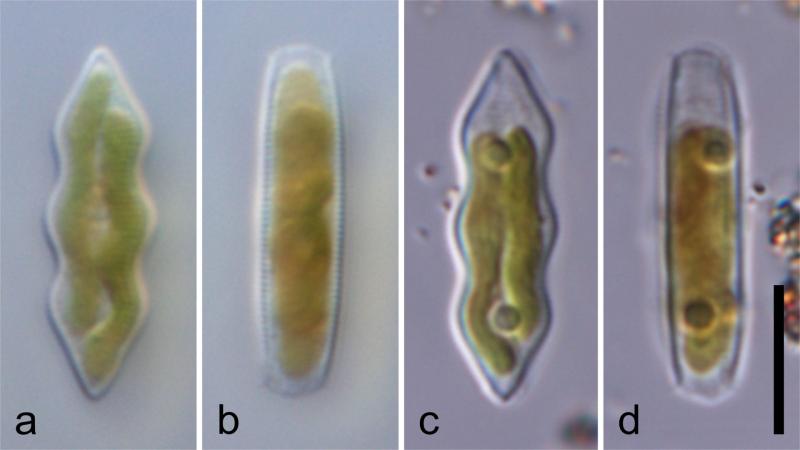
Diatoms are single-celled algae that occur either solitarily or in colonies of millions, where there is moisture. However, what distinguishes these microscopic creatures from the rest of the algal groups is their enshrining and tortuous cell-wall or 'frustule', which is made up of silica. In other words, each diatom lives in a uniquely shaped house of glass! This feature has intrigued scientists for generations, leading to the recognition of about 250 genera and over 100,000 species of diatoms till date.
In a recent study, researchers from Agharkar Research Institute, India, Harbin Normal University, China and the University of Colorado, USA, have described a new genus of diatoms called Kulikovskiyia. Diatoms belonging to this genus are currently found only in the Western Ghats of India and Hainan Province of China. The study, funded by the Science and Engineering Research Board, was published in the journal Phycological Research.
The diversity of diatoms in India are not yet well understood, particularly in the ecological hotspots of the northern region of the Western Ghats, which has iron oxide-rich 'lateritic' soil.
"The biodiversity of the Indian lateritic plateaus are still unknown," says Dr Karthick Balasubramanian from ARI, and an author of the current study. "Thus, our work was aimed at understanding the diatom diversity in these lesser-known ephemeral habitats," he adds.
Diatoms have been around for millions of years and come in a colourful array of shapes and sizes. While research on freshwater diatoms has recently received a renewed interest, many Asian diatomists still refer to a landmark publication called Mikrogeologie. It is a magnum opus written by a renowned German naturalist, Prof. Christian Ehrenberg, dating back to 1854.
"In this publication, Ehrenberg has described many new species of diatoms from various parts of India, including the Western Ghats, Ganges, Brahmaputra and the east coast," says Dr Balasubramanian.
With numerous biodiversity hotspots, Asia is home to nearly twice the number of endemic freshwater diatoms as compared to all other continents combined—a fact unearthed by Prof. Patrick Kociolek and his team of researchers. Prof. Kociolek, from the Museum of Natural History of the University of Colorado, is a leading researcher on diatoms of Asia.
In India, the researchers of the current study collected study samples by squeezing pipeworts (Eriocaulon sp.), found in a road-side trench near Padel village of Devgad Taluka of Maharashtra. After processing the diatoms in the samples, they documented their various morphological features, including the symmetry of the frustule, valves that make up the frustule, and rows of fissures or striae located along the valves. The researchers found a few genera of known diatoms, like Stauroneis, Brachysira, Frustulia and Gomphonema. They also found rare, boat-shaped diatoms, which were previously unknown.
The researchers classified these new diatoms under the new genus Kulikovskiyia. The name is dedicated to Dr Maxim Kulikovskiy of Russia, in recognition of his outstanding contributions to the study of diatoms, particularly in Asia. They named the new species of diatoms as Kulikovskiyia triundulata, referring to the three undulate on the frustule outline. This species was also found in rocky freshwater pools in Ratnagiri district of Maharashtra and Kivona plateau in South Goa.

Study Site. Images from Roy et.al, 2019, Phycological Research
Interestingly, the researchers found some similarities between the new species and the diatoms found in an unnamed river in Hainan, China. The Chinese sample had a single valve as compared to the ones discovered in India. There were also small differences in the striae patterns, suggesting that it could be classified as a new species under the same genus.
"We can't explain why we found these diatoms in plateaus pools in the Western Ghats and then in a river in China," remarks Dr Balasubramanian.
The researchers stress the need for further research to determine the exact taxonomy and ecology of the new species, and more research will fill the missing links.
The morphology of diatoms belonging to Kulikovskiyia is similar to another genus of diatoms known as Playaensis, which is found only in the shallow lakes of southwestern and west America. However, there are subtle differences. For instance, small siliceous nodules that cover the valve exterior of Playaensis are lacking in Kulikovskiyia. Moreover, the striae are almost parallel in Kulikovskiyia, whereas in Playaensis, they surround the centre of the valve.
"This similarity is possibly due to the limited studies on the subject. There may be many intermediate taxa that are yet to be discovered," says Dr Surajit Roy, the lead author of the study, commenting on this strange connection between Asia and America.
Though minute, diatoms play a crucial ecological role in the earth's carbon and nitrogen cycle and are responsible for naturally removing tons of carbon dioxide from the atmosphere and storing it in the oceans. Since they have survived for millions of years, they act as health indicators of aquatic systems in which they thrive. Given that so much of Asia is yet to be studied concerning freshwater diatom biodiversity, the study opens up the possibility of many new genera and species of diatoms that might soon turn up.
This article has been run past the researchers, whose work is covered, to ensure accuracy.





